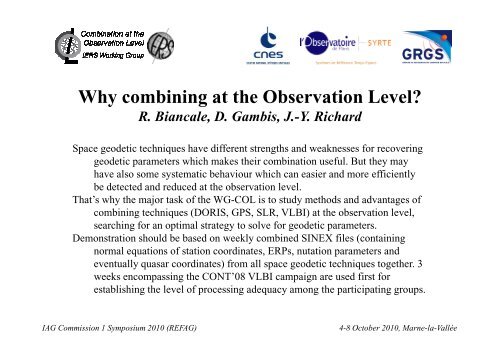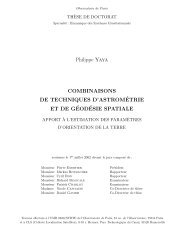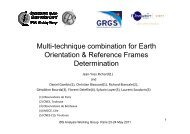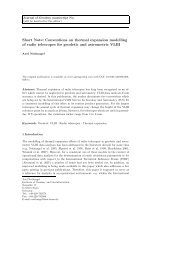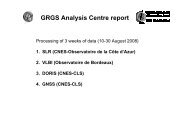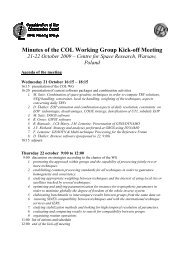Combination at the Observation Level - IERS
Combination at the Observation Level - IERS
Combination at the Observation Level - IERS
Create successful ePaper yourself
Turn your PDF publications into a flip-book with our unique Google optimized e-Paper software.
Why combining <strong>at</strong> <strong>the</strong> Observ<strong>at</strong>ion <strong>Level</strong>?R. Biancale, D. Gambis, J.-Y. RichardSpace geodetic techniques have different strengths and weaknesses for recoveringgeodetic parameters which makes <strong>the</strong>ir combin<strong>at</strong>ion useful. But <strong>the</strong>y mayhave also some system<strong>at</strong>ic behaviour which can easier and more efficientlybe detected and reduced <strong>at</strong> <strong>the</strong> observ<strong>at</strong>ion level.Th<strong>at</strong>’s why <strong>the</strong> major task of <strong>the</strong> WG-COL is to study methods and advantages ofcombining techniques (DORIS, GPS, SLR, VLBI) <strong>at</strong> <strong>the</strong> observ<strong>at</strong>ion level,searching for an optimal str<strong>at</strong>egy to solve for geodetic parameters.Demonstr<strong>at</strong>ion should be based on weekly combined SINEX files (containingnormal equ<strong>at</strong>ions of st<strong>at</strong>ion coordin<strong>at</strong>es, ERPs, nut<strong>at</strong>ion parameters andeventually quasar coordin<strong>at</strong>es) from all space geodetic techniques toge<strong>the</strong>r. 3weeks encompassing <strong>the</strong> CONT’08 VLBI campaign are used first forestablishing <strong>the</strong> level of processing adequacy among <strong>the</strong> particip<strong>at</strong>ing groups.IAG Commission 1 Symposium 2010 (REFAG)4-8 October 2010, Marne-la-Vallée
Example of ERP residual signal (wrt to <strong>IERS</strong>-C04)from different techniques (GPS and VLBI)Diurnal and sub-diurnal vari<strong>at</strong>ions in <strong>the</strong> Earthrot<strong>at</strong>ion from 6h pole parameter adjustmentGPS onlyGPS+VLBISource: GRGSPrograde part of <strong>the</strong> complex spectrum of polar motion over 2007-2008.A strong diurnal peak still appears in both series. Ano<strong>the</strong>r peak <strong>at</strong> 1.18 d(0.85 cy/d) may be subject to doubt.
Example of st<strong>at</strong>ion network behaviour vs. ITRF2008Source: ITRF2008Weekly DORIS st<strong>at</strong>ionsolutions exhibit system<strong>at</strong>icdiscrepancies in transl<strong>at</strong>ion(mainly in Z) and scale whichexpress weaknesses of <strong>the</strong>technique in comparison tocombin<strong>at</strong>ion (ITRF2008).Could rigorous techniquecombin<strong>at</strong>ion reduce <strong>the</strong>sediscrepancies?Each technique or network present strengths and weaknesses in terms ofaccuracy or distribution. Consistency has to be reach by optimal combin<strong>at</strong>ionwith <strong>the</strong> help of :- well distributed st<strong>at</strong>ion co-loc<strong>at</strong>ions and realistic weighting str<strong>at</strong>egy; anhomogeneous network of fundamental geodetic observ<strong>at</strong>ories is desirable;- geodetic s<strong>at</strong>ellite missions boarding several tracking equipments (like Jason);why not a dedic<strong>at</strong>ed s<strong>at</strong>ellite mission combining a VLBI antenna, GNSSreceivers, laser retroreflectors… for reducing system<strong>at</strong>ic errors?
Can technique combin<strong>at</strong>ion <strong>at</strong> <strong>the</strong> observ<strong>at</strong>ion levelimprove accuracy and consistency of EOP, TRF, CRF?<strong>IERS</strong> has cre<strong>at</strong>ed a dedic<strong>at</strong>ed framework for studying combin<strong>at</strong>ion:2002 – cre<strong>at</strong>ion of <strong>the</strong> <strong>IERS</strong> <strong>Combin<strong>at</strong>ion</strong> Research Centres (11 CRCs)2004 – <strong>IERS</strong> proposal of <strong>Combin<strong>at</strong>ion</strong> Pilot Project (CPP)2009 (21-22 October) – kick-off meeting of <strong>the</strong> COL-WG“<strong>Combin<strong>at</strong>ion</strong> <strong>at</strong> <strong>the</strong> Observ<strong>at</strong>ion <strong>Level</strong>” Working Group charter:COL-WG major task will be to study methods and advantages of combiningtechniques <strong>at</strong> <strong>the</strong> observ<strong>at</strong>ion level, searching for an optimal str<strong>at</strong>egy to solvefor geodetic parameters. Demonstr<strong>at</strong>ion should be based on weekly combinedSINEX files (containing unconstrained normal equ<strong>at</strong>ions of st<strong>at</strong>ion coordin<strong>at</strong>es,EOPs, nut<strong>at</strong>ion parameters and eventually quasar coordin<strong>at</strong>es) from all spacegeodetic techniques toge<strong>the</strong>r.
Goals of <strong>the</strong> COL-WG• to improve precision, resolution and consistency of products(EOP, TRF, CRF) cre<strong>at</strong>ing common standards for a rigorouscombin<strong>at</strong>ion• to extend <strong>the</strong> combin<strong>at</strong>ion approach <strong>at</strong> <strong>the</strong> level of observ<strong>at</strong>ionto several research groups in a planned <strong>IERS</strong> action• to mutualize physical parameters (eg. troposphere) and to studytechnique dependent system<strong>at</strong>ic errors• to progress in combin<strong>at</strong>ion methods and str<strong>at</strong>egies (eg.weighting)• to valid<strong>at</strong>e <strong>the</strong> rigorous combin<strong>at</strong>ion approach vs. presentrealiz<strong>at</strong>ions (C04, ITRF…)• to prepare future of <strong>IERS</strong>…
COL Str<strong>at</strong>egy4⎛∑⎜∑CC⎝nACindividual⎞technique⎟⎠⇒n′∑⎜∑CC′⎛⎝≥2COLmulti⎞− technique⎟⎠4∑CC( ) ⇒ ∑( )Improving <strong>the</strong> combin<strong>at</strong>ion approach by searching for homogeneity “<strong>at</strong> <strong>the</strong> levelof observ<strong>at</strong>ions” in terms of :• precision (considering system<strong>at</strong>isms and common parameters => troposphere)• resolution (considering observ<strong>at</strong>ion densific<strong>at</strong>ion => 3h EOP sampling)• consistency (wrt modelling standard, software => comparison campaign)n′CC′should increase accuracyMutual inform<strong>at</strong>ion from <strong>the</strong> different techniques should complement andimprove global products taking advantage of strengths of each technique throughan homogeneous processing
Present COL participants• AIUB: BERNESE• DGFI: DOGS-OC/-CS (+ OCCAM)• ESOC: NAPEOS• GFZ: EPOS• GRGS: GINS/DYNAMOO<strong>the</strong>r potential COL participants• JPL: GIPSY/OASIS• GSFC: GEODYN/SOLVE• ASI: GEODYN• …Prerequisiteprocessing must be <strong>at</strong> <strong>the</strong> quality level of <strong>the</strong> Technique Intern<strong>at</strong>ional Services
<strong>Combin<strong>at</strong>ion</strong> <strong>at</strong> <strong>the</strong> NEq level vs. observ<strong>at</strong>ion level∑i– with <strong>the</strong> same software handling several techniques– with different software packages if <strong>the</strong>y are well homogenizedcalc n calc∂Q⎛ Q⎞i ⎜∂ipjQ ⎟i= 0 ∀k= ,np∑ ∆ − ∆∂k j p1⎝ = 1 ∂j ⎠NEQ levelObserv<strong>at</strong>ion levelConsistent processing of <strong>the</strong> d<strong>at</strong>a using <strong>the</strong> same models and parameteriz<strong>at</strong>ion∆Q= Q− QcalciAppropri<strong>at</strong>e rel<strong>at</strong>ive weighting of <strong>the</strong> techniquesCorrections to <strong>the</strong> original observ<strong>at</strong>ions are estim<strong>at</strong>edOutlier detection and weighting ofobserv<strong>at</strong>ions technique-wiseA priori reduced parameter cannot behandled anymoreiobsi=n∑j=1∂Q∂pij∆pOutlier detection and weighting ofobserv<strong>at</strong>ions within <strong>the</strong> combin<strong>at</strong>ionprocessAll parameters are availableSeitz, Thaller - Workshop on <strong>Combin<strong>at</strong>ion</strong> on Observ<strong>at</strong>ion <strong>Level</strong>, 21./22.10.09, WarsawOnly technique dependent parameters can be reduced for an actualequivalence between NEq level and observ<strong>at</strong>ion levelj
<strong>Combin<strong>at</strong>ion</strong> <strong>at</strong> <strong>the</strong> observ<strong>at</strong>ion level vs. NEq levelExample: Jason2 - 7 day arc over <strong>the</strong> period: 17/8/2008 – 23/8/2008Technique Nb of observ. Residuals Orbit #rmsSLR 2216/224 4.1cm 12.1cmDORIS 109884/52825 .346mm/s 10.6cmSLR +DORIS2247/193109614/530954.2cm.352mm/sX-Pole / dY-Pole / d
Problem of EOP interpol<strong>at</strong>ionAIUBGFZSeitz, Thaller - Workshop on <strong>Combin<strong>at</strong>ion</strong> on Observ<strong>at</strong>ion <strong>Level</strong>, 21./22.10.09, Warsaw0h 6 12 18 0h 6 12 18 0h 6 12 18 0hGRGSDensified piece-wise linear Polygon4n+1 parameters“real”continuity achievedno linearity continuity conditions constraints by segment needednot distinguishable from “offset-only” in SINEX
Example of ERP undersamplingGPS - from 6 hr to 1 dayday from 2005 day from 2005by linearity constraints:=> One can densify <strong>the</strong> EOP parameteriz<strong>at</strong>ion (to 3hr for instance) to be closerto <strong>the</strong> temporal d<strong>at</strong>a distribution (mainly for VLBI) and apply linearityconstraints afterwards if needed
First actions of <strong>the</strong> COL-WGTo intercompare results of different software packagesDefining benchmarks: <strong>the</strong> period chosen for establishing benchmarks is fromAugust 10 to August 30, 2008. It includes <strong>the</strong> intensive CONT08 VLBIperiod (from 12 to 26/08/08). Combined SINEX will be delivered per week.They could be separ<strong>at</strong>ed per technique.Estim<strong>at</strong>ing parameters: <strong>the</strong> non reduced parameter set should include EOP (pole,UT1, nut<strong>at</strong>ion parameters per day and possibly drifts), st<strong>at</strong>ion coordin<strong>at</strong>es (perweek), troposphere zenith delay ZTD (per hour). In order to reduce <strong>the</strong> size ofSINEX files, troposphere parameters of non colloc<strong>at</strong>ed GPS st<strong>at</strong>ions can bepreviously reduced.Schedule:2009: cre<strong>at</strong>ion of <strong>the</strong> COL forum and discussion on a priori models and parametersFebruary 2010: first delivery of SINEXJune 2010: second delivery of SINEXEnd 2010: need for result discussion and reiter<strong>at</strong>ion
Remaining problems in delivered SINEX filesAIUB weekly SLR : XPO, YPO, UT <strong>at</strong> 00h + r<strong>at</strong>es <strong>at</strong> 12h + st<strong>at</strong>ionsdaily GPS : EOP <strong>at</strong> 00h + st<strong>at</strong>ions + CoM + troposphereErroneous number of unknownsDGFI weekly SLR : XPO, YPO, UT <strong>at</strong> 00h + st<strong>at</strong>ionsBlocks STATISTICS and APRIORI invertedUnits of XPO, YPO “as”, must be in unit “mas”Units of UT “s”, must be in unit “ms”daily VLBI EOP <strong>at</strong> 11h + r<strong>at</strong>es <strong>at</strong> 11h + st<strong>at</strong>ionsGFZ daily GNSS+SLR : XPO, YPO, UT <strong>at</strong> 00h + st<strong>at</strong>ionsErroneous number of unknownsblock: SOLUTION/MATRIX_ESTIMATE L INFOinstead of SOLUTION/NORMAL_EQUATION_MATRIX LESOCGRGSweekly DORIS+SLR XPO, YPO, XPOR, YPOR, LOD <strong>at</strong> 12h + st<strong>at</strong>ions + SLR range biasBad APRIORI for SITE 1873 A 1 L 49000:**:***:*****:Erroneous number of unknownsweekly GNSS+SLR XPO, YPO, XPOR, YPOR LOD <strong>at</strong> 12h + st<strong>at</strong>ions + SLR range biasErroneous number of unknownsweekly DORIS/VLBI XPO, YPO, UT <strong>at</strong> 0, 6, 12,18h, NUT-OB/LN <strong>at</strong> 0, 12h + tropo./GPSabsolute a priori zenital delay and st<strong>at</strong>ion number missing (not domes)weekly SLR EOP <strong>at</strong> 00h
Roadmap (where we are)1) review <strong>the</strong> approach of <strong>the</strong> various groupsand <strong>the</strong>ir capability to process two or more techniques.2) establishing common processing standardsfor all techniques in order to guarantee homogeneity and consistency.3) optimizing and unifying parameteriz<strong>at</strong>ionfor instance for tropospheric parameters in order to minimize globally <strong>the</strong> degree of freedomof <strong>the</strong> whole inverse system.4) studying <strong>the</strong> appropri<strong>at</strong>e weighting between techniquesand <strong>the</strong> use of local ties or identical s<strong>at</strong>ellites tracked by several techniques.5) elabor<strong>at</strong>ing benchmarksto intercompare results between groups from <strong>the</strong> same d<strong>at</strong>a set.6) insuring SINEX comp<strong>at</strong>ibilitybetween techniques and with <strong>the</strong> intern<strong>at</strong>ional technique services and <strong>IERS</strong>.7) studying stabiliz<strong>at</strong>ion methodsand looking for high temporal resolution of parameters.8) evalu<strong>at</strong>ing and comparing resultsto search for comp<strong>at</strong>ibility between groups.9) organizing routine oper<strong>at</strong>ionsfor a new TRF realiz<strong>at</strong>ion, ei<strong>the</strong>r in <strong>the</strong> framework of <strong>the</strong> next ITRF or as ITRF assessment.


